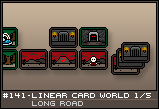| Three Hundred |
| - Index Page |
| - About... |
| - By Year |
| Collections |
| - Comp-Grid |
| - Procedural |
| - Tactics |
| - Tiny Crawl |
| - Misc |
| Previous | Mechanic #141 | Next |
![[experiment.png]](set08/img/entry141-experiment.png)
I'm doing a little experiment over the next few entries. I'm going to take a single structural mechanic and I'm going to build five different game concepts around it. For this experiment, the mechanic I have chosen is: A world map based on a series of cards laid end to end in a linear manner. Each card represents a room, which can contain pawns, chits, or markers representing game objects. There is no y-axis, at least in the typical concept of two-dimensional maps, making this a more restrictive mechanic than something like [#124 - Card Metroidvania].
![[world1.png]](set08/img/entry141-world1.png)
The centerpiece of this game concept is that the world is a single, linear line that can be traveled, in either direction, infinitely. As you explore to the right, you gain new world cards which you can append to the line. As you run out of table space, you can store cards on the left or right into a stack, allowing an ease of storage and retrieval. You might only keep the current five cards on the table at any one time, but you can return all the way to the beginning at any time, allowing for an infinitely sized world.
The world is built via a series of linear decks, each one representing a zone in the world. When you get to the end of the world, you can draw a card from the current zone's deck. If it is a world card, append it to the end of the world. If it is a feature (like a town, cave, or dungeon) simply place it above the current world card. When you run out of cards in the current zone deck, move on to the next zone deck. The features can be visited from their world node by simply moving up. Each one is some sort of randomized challenge, perhaps involving building a separate, smaller linear world to explore. Or perhaps they are just a series of random encounters that must be defeated in order, with the last one yielding some treasure at the end. Whatever the case, the features are less important than the world.
![[world2.png]](set08/img/entry141-world2.png)
Unless you have a very large table, this lengthy line of cards is going to grow too big. In order to facilitate a large world, we can store cards that are outside the current scope in a stack - the world card, then the feature cards in order on top of it. This will be placed in a storage stack to either end of the world. To "scroll" along the world, simply store a card on the stack at one end, shift the cards over, and retrieve the top of the stack at the other. To retrieve a world card, just grab everything until the first world card and stack them up at the end. Since the cards are stacked in LIFO (last in, first out) order, the last card stack stored will be the first card stack restored. This allows the active field of the game to scroll, and also allows it to scale to the size of whatever table you are using.
As you travel through this world, you will encounter treasure and enemies - represented as a themed deck of cards. Simply take the top card and resolve the encounter. Where this differs slightly is that the encounter cards are tiered, based on the players level, with multiple potential encounters being listed on a single card. For instance, say you draw a Kobold Gang card. It may have five different encounters listed along with the following level ranges:
Levels 8-11: Two Kobolds, One Kobold Archer Levels 12-15: One Kobold, One Kobold Archer, One Kobold Defender Levels 16-20: Two Kobold Defenders, One Kobold King Depending on the current level of the hero character, he could encounter any one of these four encounters. The level ranges do not have to be the same. One encounter may simply have two tiers, levels 1-10 and 11-20. This way, you don't end up with the first level of a tier being more difficult than the last one, since just as often, the first level of a tier may end up being the last level (or even middle level) or a previous tier on a different card. Treasure cards are tiered as well, but by setting them into stacks for each five levels. So you'll have a stack of treasure and items for levels 1-5, one for 6-10, then 11-15, and finally 16-20. When you defeat an encounter, it will allow you to take one or more cards from the tiered treasure stacks. Generally, you take the cards from whatever tier your level is in. However, COMMON treasure is always taken from the first tier, INFERIOR treasure taken from the tier below, SUPERIOR treasure from the tier above, and LEGENDARY treasure from the top tier, irregardless of your current level. At level one, for example, normal, COMMON, and INFERIOR treasure all comes from the first stack, with SUPERIOR coming from tier 2, and LEGENDARY from tier 4.
|
